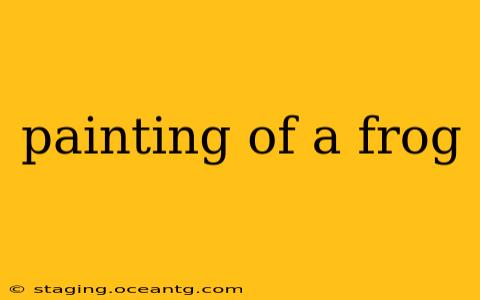Frogs, with their vibrant colors, captivating eyes, and unique textures, make fascinating subjects for artists of all skill levels. Whether you're a seasoned painter or just starting out, capturing the essence of a frog on canvas requires careful observation and understanding of its form and features. This guide will help you navigate the process, from choosing your materials to mastering the techniques necessary to bring your amphibian muse to life.
What Kind of Paint is Best for Painting a Frog?
The best paint for painting a frog depends largely on your personal preference and the desired effect. Acrylics are a popular choice for beginners due to their quick drying time and water-based cleanup. Oils offer a richer, more luminous quality but require more time to dry and the use of solvents for cleanup. Watercolors, with their delicate transparency, can create beautiful, ethereal frog portraits, particularly when capturing the subtle nuances of light and shadow. Gouache, a water-based opaque paint, offers a vibrant, matte finish. Ultimately, the "best" paint is the one that you find most enjoyable and conducive to your artistic style.
How Do I Paint a Realistic Frog?
Painting a realistic frog hinges on accurate observation and attention to detail. Start by studying your subject carefully. Note the shape and placement of its eyes, the texture of its skin, the unique patterns of its coloration, and the subtle gradations of light and shadow across its body. Use a variety of brushstrokes to mimic the different textures – smooth strokes for the glossy eyes, shorter, more textured strokes for the bumpy skin. Pay close attention to the anatomy of the frog, particularly the positioning of its limbs and the overall posture. Accurate rendering of these elements will contribute significantly to the realism of your painting. Consider using photographs as references, particularly if you're painting from life isn't feasible.
What are Some Easy Frog Painting Ideas for Beginners?
Beginners can start with simplified forms and bolder colors to gain confidence. Try a cartoonish frog, focusing on simple shapes and bright, contrasting hues. Another approach could be a stylized frog, emphasizing certain features like the eyes or the texture of the skin while simplifying other details. Painting a frog in profile can also be easier than tackling a more complex frontal view. Remember that even simple paintings can be captivating if you focus on strong composition and color choices. Don't be afraid to experiment and let your creativity shine!
What Colors Should I Use to Paint a Frog?
The color palette you choose will depend on the species of frog you're painting. Some frogs are predominantly green, others brown or even brightly colored with striking patterns. Start by identifying the primary colors of your frog and then add secondary and tertiary colors to create depth and nuance. Consider the environment where your frog lives; the background colors will also influence your palette. Remember to mix your colors to create subtle gradations and avoid flat, unrealistic tones. Use a limited palette initially to focus on mastering color mixing, then gradually expand your range as you gain confidence.
How Do You Paint a Frog's Skin Texture?
Capturing the texture of a frog's skin is crucial for creating a believable depiction. Use different brushstrokes to represent the various textures – smooth strokes for smooth areas, short, dabbing strokes for bumpy skin, and longer strokes for the smoother parts of the legs. Consider using a palette knife to create a more textured effect. The use of impasto techniques (applying paint thickly) can add a three-dimensional quality to the frog's skin. Remember, variations in texture and color add visual interest and realism.
This guide provides a starting point for your artistic exploration of the frog. Remember, practice and observation are key to improving your skills. Don't be afraid to experiment, and most importantly, have fun!
